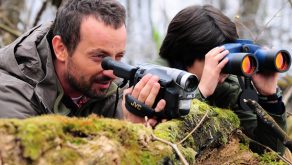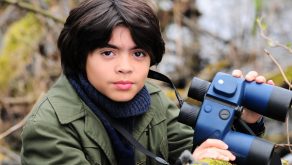“We intended to cut before the kissing started”
 Visiting his divorced dad – an ornithologist with a special interest in cranes – Igor (11) witnesses a crane chick hatching from an egg and names it ‘Karl’. When mum decides to start a new life in Israel, Igor has a hard time settling in the new country. Meanwhile Karl is about to set off on its winter migration to Africa, a life-threatening journey. Karl might set ‘foot’ on Israeli ground, luring dad on his trail to study the bird’s migration patterns. Igor decides to build a winter home to welcome Karl.
Visiting his divorced dad – an ornithologist with a special interest in cranes – Igor (11) witnesses a crane chick hatching from an egg and names it ‘Karl’. When mum decides to start a new life in Israel, Igor has a hard time settling in the new country. Meanwhile Karl is about to set off on its winter migration to Africa, a life-threatening journey. Karl might set ‘foot’ on Israeli ground, luring dad on his trail to study the bird’s migration patterns. Igor decides to build a winter home to welcome Karl.
In many festivals the little bird has already charmed every young audience, but… could it have been any other birds than cranes?
Evgeny Ruman: “It simply had to be cranes. These birds connect Israel with Russia. Being born in Belarus, I can tell you that cranes are ‘nested’ deep in the Russian culture. THE CRANES ARE FLYING (by Mikhail Kalatozov, 1957) is one of my all-time favourite movies. Moreover, cranes mate for life.”
 So you can use cranes to draw the attention to a bigger problem?
So you can use cranes to draw the attention to a bigger problem?
Ruman: “Although cranes are no petty animals that you take inside your home, Igor humanizes the bird to impose some of his own problems on it. For him ‘saving the bird’ equals ‘saving himself’. He has difficulties putting his problems in the right perspective, ‘divorced parents’ are a common thing today, Israel has the same divorce rate as any other country. Also migration has become a common decision in life. The concept of ‘homeland’ has drastically changed over the last decades and leaving your country is no longer a social tragedy.”
But it is for the cranes. Many of them die during their migration.
Ruman: “Statistics prove that 50 % of the yearlings don’t survive their first migration trip. Also amongst grown-up cranes the death-rate is huge. Even the most renowned crane experts that we consulted couldn’t give us a reason why these birds are putting their lives at stake on this epic journey; ‘These habits have developed over centuries, but we don’t know why’.”
 Your film touches many different subjects.
Your film touches many different subjects.
Ruman: “Making choices is what a director does, deciding for every shot or scene what is important on the macro and the micro level. All the time I tried to respect the boy’s point of view, for instance when depicting grown-ups as strange, non-balanced creatures. Igor thinks grown-ups are childish, while he himself is forced to grow up fast and needs a strong person to rely on. The relationship between Igor and his father is the beating heart of the story.”
Which countries were involved in the production? And how? And why?
Ruman: “IGOR AND THE CRANES’ JOURNEY is an Israeli-Polish-German coproduction with a universal subject and international appeal. In Poland we shot the scenes situated in Russia. The Polish swamps and birches look exactly like the cranes’ Russian biotope.”
How easy is it to capture cranes on film?
Ruman: “Much more difficult than we expected. They are so shy. Our visual effects supervisor did a fantastic job; he made everything look real. For the first time I discovered the power of visual effects in adjusting reality.”
 In the film Hula Valley sounds like an almost mythical place, but does it really exist?
In the film Hula Valley sounds like an almost mythical place, but does it really exist?
Ruman: “It’s in the North of Israel and it’s the world’s largest ‘transit zone’ for migrating birds. Although you’ll find all sorts of birds there, everyone knows it as the place where the cranes land. Also the common ‘grey crane’, which is the one the movie is about. Once, Hula was an enormous swamp that ran dry. Now the water has been brought back to Hula, the swamp is expanding. It’s a popular place to go bird watching with children. Shooting footage in Hula Valley, the sounds and visuals were amazing.”
Another remarkable location is the Israel-Lebanon border, where dad is held up by over-diligent soldiers. Why is that scene in the movie?
Ruman: “There was no ideological reason. It is just a part of the story, as this border policy is a natural part of our life, that we’ve learned to accept.”
I found the scenes about renovating the small pond for the coming of the cranes very inspiring. Like a manual on how to improve your own small environment.
Ruman: “Igor is a dreamer, investing energy in a case that other people would call ‘a waste of time’. Idealists like him have to realize that it’s important to make small changes in your own world, even if from a rational point of view it doesn’t make much sense.”
Itai Shcherback keeps his acting subtle and introvert.
Ruman: “I didn’t want the story to feel too sentimental or manipulative. Most of the action speaks for itself. I asked Itai not to act out, although in real life he is very verbal and energetic. I calmed him down to keep his character more introvert.”
You sometimes even replace him by animation.
Ruman: “Igor almost feels like a grown-up. Childish things he doesn’t want to share with anybody. Those are the things we show in naïve animations.”
Also his first kiss is shown in animation. Was real life kissing ever an option?
Ruman: “Never! We intended to cut before the kissing started. Until my editor had the idea to animate the kiss. That’s what a good director does: using other people’s ideas if they’re better than his!”
The film has not yet been released in Israel.
Ruman: “It will be released in March. On the small Israeli market we can’t compete with Hollywood. But I think it’s important for every country to produce something different, with a direct appeal to real children’s life.”
Gert Hermans
